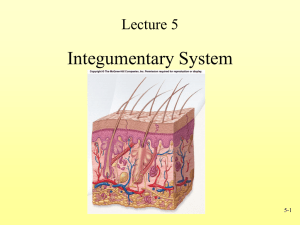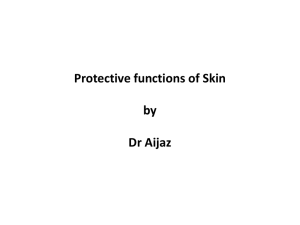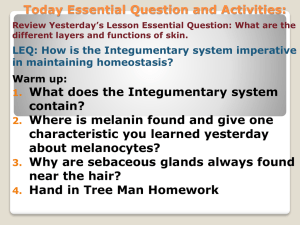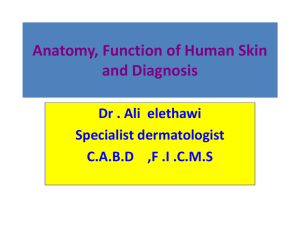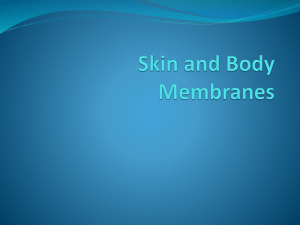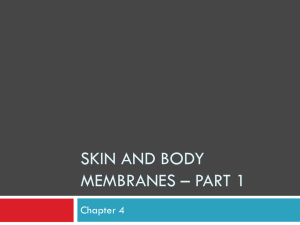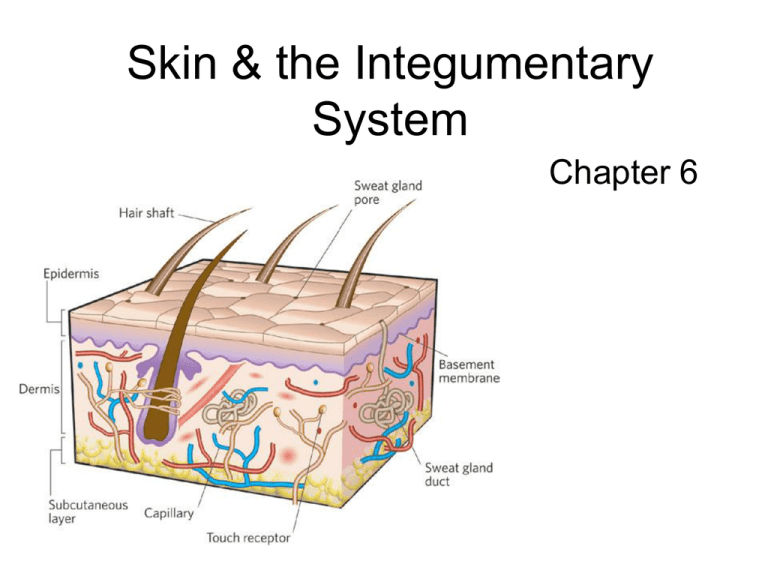
Skin & the Integumentary
System
Chapter 6
Lesson Objective
• Students will know the parts of the
integumentary system.
Skin
Hair
Nails
cutaneous glands
6.1 Introduction
• The cutaneous membrane commonly
called skin together with certain accessory
organs make up the integumentary
system.
• The integumentary system consists of the
skin, hair, nails, and cutaneous glands.
• The skin provides a barrier against
microorganisms, water, solar radiation,
and others.
• Upon exposure to UV radiation, the skin
synthesizes an inactive form of vitamin D.
• The skin is the most extensive sense
organ and is important in
thermoregulation.
Lesson Objective
• Students will know the 4 type of
membranes.
Cutaneous membranes.
Serous membranes.
Mucous membranes.
Synovial membranes.
6.2 Types of membranes
The four types of membranes are:
1) Cutaneous membranes. The cutaneous membrane is the
skin. This membrane is composed of a layer of epithelium
over a layer of connective tissue.
2) Serous membranes. Serous membranes line body cavities
(peritoneum) and surround organs such as the lung (pleura)
and heart (pericardium). Do not open to the outside
3) Mucous membranes. Mucous membranes are tissues that
line body cavities or canals such as the throat, nose, mouth,
urethra, rectum, and vagina. Open to the outside.
4) Synovial membranes. Synovial membrane is a layer of
connective tissue that lines the cavities of joints, tendon
sheaths, and bursae (fluid sacs) and makes synovial fluid,
which has a lubricating function.
Lesson Objective
• Students will understand the basic
structure of skin.
Epidermis-protection
Dermis-nourishment
Hypodermis-insulation
6.3 Skin & its tissues
The skin, or integument, is the
largest of the body organs.
It includes two distinct tissue
layers—the superficial layer,
called the epidermis, and a
deeper layer, called the dermis.
A third layer,
the hypodermis (sometimes
called subcutaneous tissue), is
not part of the skin, but serves
to anchor the skin to underlying
bone and muscle tissue.
Epidermis
• The epidermis consists of five distinct layers,
none of which contain any blood vessels.
• The deepest layer of the epidermis, the stratum
basale, contains cells undergoing mitosis.
• The outermost layer, the stratum corneum, is
composed of many layers of dead, flattened
epidermal cells.
• Main Function of Epidermis is PROTECTION.
Epidermis
• Most of the cells in the epidermis are
keratinocytes, which produce a protein mixture
called keratin.
• Keratinocytes are responsible for the structural
strength and permeability characteristics of the
epidermis.
• Keratinization is the hardening of older cells. As
a result, many layers of tough, tightly packed
deal cells accumulate in the outer epidermis.
Dead cells are eventually shed.
• Other cells of the epidermis
include melanocytes, Merkel cells, and
Langerhans cells.
• Melanocytes produce melanin, a pigment
that results in dark skin color and protects
the skin from ultraviolet radiation. All people
have about the same number of melanocytes
in their skin. Differences in the amount of
melanin determine skin color.
• Merkel cells are touch receptors.
• Langerhans cells are macrophage. The
epidermis protects underlying tissue against
water loss, mechanical injury, and the effects
of harmful chemicals.
• A tan indicates sun damage to the skin.
Dermis
• The dermis binds the epidermis to underlying
tissues. The dermis consists of areolar tissue
and dense irregular connective tissue. Dermal
blood vessels supply nutrients to all skin cells
and help regulate body temperature.
• Sensory nerve fibers, hair
follicles, sebaceous glands, sweat glands,
and nail roots are all found within the dermis.
• Main function of dermis is to NOURISH
epidermis
Dermis
• The strength of the dermis in mainly due to
the presence of collagen fibers.
• Projections of the dermis (dermal papillae)
passing into spaces of the epidermis cause
uneven undulations of the skin called finger
prints. Genes cause fingerprints but they can
change slightly as a fetus moves and
presses the forming ridges against the
uterine wall. This is why identical twins
fingerprints are not exactly alike.
Subcutaneous
• The hypodermis (subcutaneous layer) is
deep to the dermis and consists of loose
connective tissue and adipose tissue.
Approximately half of the body's stored fat
is found in the hypodermis, although the
amount and location vary with age, sex,
and diet.
• The fat in the hypodermis functions as
padding and INSULATION.
Lesson Objective
6.4 Accessory Organs of the Skin
1.
2.
3.
4.
Hair follicles
Sebaceous glands
Nails
Sweat glands
The average square inch of skin holds
650 sweat glands, 20 blood vessels,
60,000 melanocytes, and more than a
1,000 nerve endings.
Hair Follicles
• Hair is present on all skin surfaces except
the palms, soles, lips, nipples, and parts of
the external reproductive organs.
• Hair develops from a tube-like depression
called a hair follicle.
• The follicle extends from the surface into the
dermis and contains the hair root.
• As the epidermal cells divide and grow, older
cells are pushed toward the surface. A hair is
composed of dead epidermal cells.
A bundle of
smooth muscle
cells form the
arrector pili
muscle.
Remember
smooth muscle
is involuntary.
If a person is emotionally upset or very
cold, nerve impulses ,stimulate the
muscle to contract, causing goose
bumps.
Sebaceous Glands
• Contain groups of specialized epithelial cells
and are usually associated with hair follicles.
• Holocrine glands secrete oily mixture of fatty
material and cellular debris called sebum.
• Sebum helps keep the hair and skin soft,
pliable, and waterproof.
• Many teens are familiar with a disorder of
the sebaceous glands called acne.
Overactive and inflamed glands in some
body regions become plugged and
surrounded by red elevations (pimples).
Nails
• Nails are protective coverings on the ends of
fingers and toes.
• Each nail consists of a nail plate that overlies
a surface of skin called the nail bed.
• The whitish, thickened, half-moon shaped
region called the lunula at the base of the
nail plate is the most active growing region.
• Nails grow from epithelial cells that divide
and become keratinized as the rest of the
nail.
Thumb nails grow the
slowest, the middle
nails grow the fastest.
Sweat Glands
• Sweat glands are exocrine glands that are
widespread in the skin.
• The most numerous sweat glands, the
eccrine glands, respond throughout life to
body temperature elevated by
environmental heat or physical exercise.
Glands are common on the forehead,
neck, and back.
• The fluid, sweat is mostly water, but also
contain salt, urea and uric acid.
• Other sweat glands, called apocrine
glands become active when a person is
emotionally upset, frightened, or in pain.
• Other sweat glands are structurally and
functionally modified to secrete specific
fluids such as the glands of the external
ear canal that secrete earwax. The female
mammary glands that secret milk are
another example of modified sweat
glands.
Lesson Objective
6.5 Regulation of Body Temperature
• Regulation of body temp is vitally
important because even slight shifts can
disrupt rates of metabolic reactions.
• The skin plays a key role in the
homeostatic mechanism that regulates
body temp.
• Heat is a product of cellular metabolism.
• 80% of the body’s heat escapes through
the head.
Homeostasis
• During intense heat (physical activity) active
muscle release heat, which the blood carries
away. The warmed blood reaches the brain that
controls the body’s set point which signal
dermal blood vessels to relax and widen
(Vasodilation),heat in the blood to skin surface.
• In very cold environments, the brain
triggers the blood vessels to contract
(vasoconstriction). If body temp continues
to drop, the nervous system stimulates
muscle fibers to in the skeletal muscles to
contract slightly to produce heat. The body
inactivates sweat glands to reduce heat
loss by evaporation. If none of these raise
body temp then small groups of muscles
contract rhythmically with still greater
force, and causes shivering, generating
more heat.
6.6 Healing of Wounds
• Blood vessels in affected tissues dilate
and become more permeable, forcing
fluids to leave the blood vessels and enter
the damaged tissue.
• Inflamed skin may become reddened,
warm, swollen, and painful to touch.
However, the dilated blood vessels
provide the tissue with more nutrients and
oxygen, which aids healing.
• If the break in the skin is shallow, epithelial
cells along the cut are stimulated to divide
more rapidly, and newly formed cells fill the
gap.
• If the injury extends into the dermis or
subcutaneous layer, blood vessels break,
and the escaping blood forms a clot. The
blood clot and dried tissues form a scab that
covers and protects the tissue.
• If the wound is extensive, the newly formed
connective tissue may appear on the surface
as a scar.
Common Skin Disorders
• Acne- disease of the sebaceous glands
that produce blackheads and pimples.
• Alopecia- Hair loss, usually sudden.
• Athlete’s foot- fungus infection usually in
the skin of the toes and soles.
• Birthmark- congenital blemish or spot on
the skin, visible at birth or soon after.
• Boil- bacterial infection of the skin,
produced when bacterial enter a hair
follicle.
Skin Disorders
• Eczema- noncontagious skin rash that
produces itching, blistering, and scaling.
• Herpes- infectious disease of the skin,
usually caused by herpes simplex virus and
characterized by recurring formations of
small clusters of vesicles.
• Mole- fleshy skin tumor that is usually
pigmented.
• Psoriasis- Chronic skin disease
characterized by red patches covered with
silvery scales.
Skin Disorders
• Scabies-disease resulting from an
infestation of mites.
• Ulcer- open sore.
• Wart- flesh-colored, raised area caused by
a viral infection.
Work Cited
• Skin cross section. Image. July 8, 2012
Human+Skin.jpg khilafatworld.com
• Hair Follicle picture. December 28, 2012.
http://www.infovisual.info/03/037_en.html
• Sebaceous gland picture. December 28,
2012.
http://www.indianwomenshealth.com







